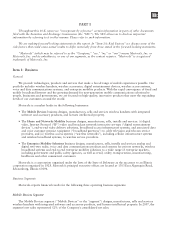Motorola 2007 Annual Report Download - page 14
Download and view the complete annual report
Please find page 14 of the 2007 Motorola annual report below. You can navigate through the pages in the report by either clicking on the pages listed below, or by using the keyword search tool below to find specific information within the annual report.
create mobile IP broadband access. WiMAX has the potential to make mobile bandwidth more affordable and
accessible for mainstream consumer adoption.
Our products are marketed primarily to cable television operators, television programmers, telecom operators,
wireless service providers and other communications providers worldwide and are sold primarily by our skilled
sales personnel.
Our Industry
The home market is evolving rapidly as cable and telecom network operators expand their video, data and
voice services (commonly known as the “triple play”) to grow their subscriber base. The competition between
cable and telecom service providers is increasing. Telecom operators are expanding their broadband networks and
beginning to offer advanced video and data services using IPTV and PON technologies. Cable operators are
responding by expanding their investment in HD programming, bundling voice-over-IP services, expanding their
broadband data service through Data Over Cable Service Interface Specifications (“DOCSIS”) 3.0 channel
bonding, and maximizing utilization of network bandwidth using switched digital video.
Our home business is subject to regulation by the FCC in the United States and other governmental
communication regulators throughout the world. On July 1, 2007, regulations enacted by the FCC became
effective, requiring separation of security functionality from cable set-tops. A full two-way security interface
continues to be refined. Once developed and implemented, these changes are expected to increase competition and
encourage the sale of set-tops and integrated devices, such as televisions and DVRs, that will allow retail customers
direct access to programming. Traditionally, service providers have leased digital entertainment devices to their
customers.
In the wireless networks market, the majority of installed cellular infrastructure systems are based on CDMA,
GSM, UMTS and iDEN technologies. We supply systems based on each of these technologies and are the sole
supplier of proprietary iDEN networks. Advanced infrastructure systems based on these technologies include
GPRS, CDMA-1X and EDGE. In addition, some segments of the cellular infrastructure industry have installed, or
are in the process of migrating to, 3G networks, which are high-capacity radio access wireless networks providing
enhanced data services, improved Internet access and increased voice capacity. The primary 3G technologies are W-
CDMA (based on either UMTS or Freedom of Mobile Multimedia Access (“FOMA”) technologies) and
CDMA2000 1xEVDO. We supply 3G systems based on UMTS and CDMA 2000 1xEVDO technologies. An
additional 3G technology standard is TD-SCDMA, driven primarily by the Chinese government and local Chinese
vendors. We expect 3G licenses to be awarded in China during 2008.
Industry standards bodies are in the process of defining the next generation of wireless broadband systems
after 3G. The Institute of Electrical and Electronics Engineers (“IEEE”) is currently developing fixed and mobile
broadband standards (802.16d and 802.16e) based on orthogonal frequency division multiplexing (“OFDM”)
technology, which will utilize wider channels and enable triple play services (voice, data, video). Based upon
developments in the 802.16e standard, we expect to see the WiMAX market begin to develop in 2008 as several
WiMAX networks come on-line and devices utilizing these networks become widely available. We are an early
leader in next-generation wireless broadband products, including WiMAX technology.
The International Telecommunications Union (“ITU”) is also adopting next-generation cellular wireless access
standards (“4G”) for the cellular infrastructure industry, also based on OFDM technology and known commonly
as Long Term Evolution (“LTE”). LTE has widespread industry support, not only from current GSM/UMTS
operators, but also from CDMA/EV-DO based carriers. Motorola has been chosen as a trial supplier for a joint
Verizon/Vodafone LTE trial that is currently underway.
Licensing bodies of governments around the world are making spectrum available for advanced wireless
technologies, including 4G, in recognition of growing demand for wireless broadband services. Currently,
Motorola estimates that there are over 1,200 licenses available worldwide for advanced wireless technologies, such
as 802.16e, with over 800 licenses outside North America.
Demand for our products depends primarily on: (i) capital spending by providers of cellular and broadband
services for constructing, rebuilding or upgrading their communications systems, and (ii) the marketing of
advanced communications services by those providers. The amount of spending by these providers, and therefore a
majority of our sales and profitability, are affected by a variety of factors, including: (i) the continuing trend of
consolidation within the cable, wireline and wireless industries, (ii) the financial condition of operators and
alternative providers, including their access to financing, (iii) technological developments, (iv) standardization
6
























